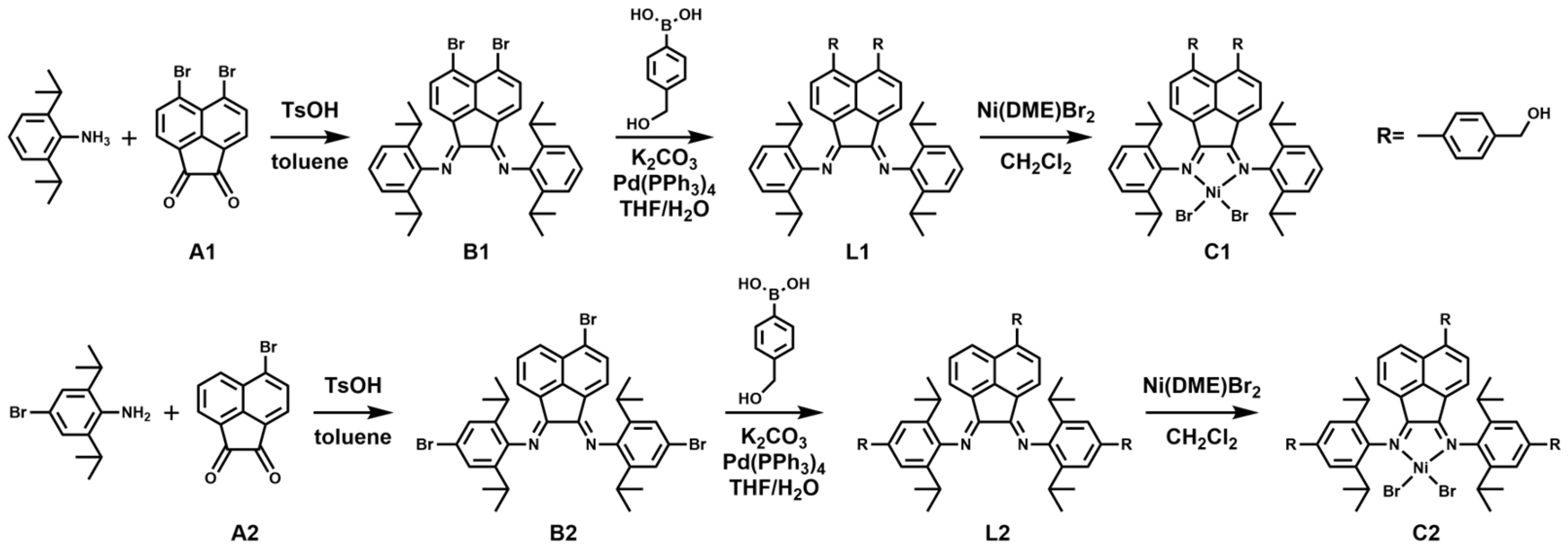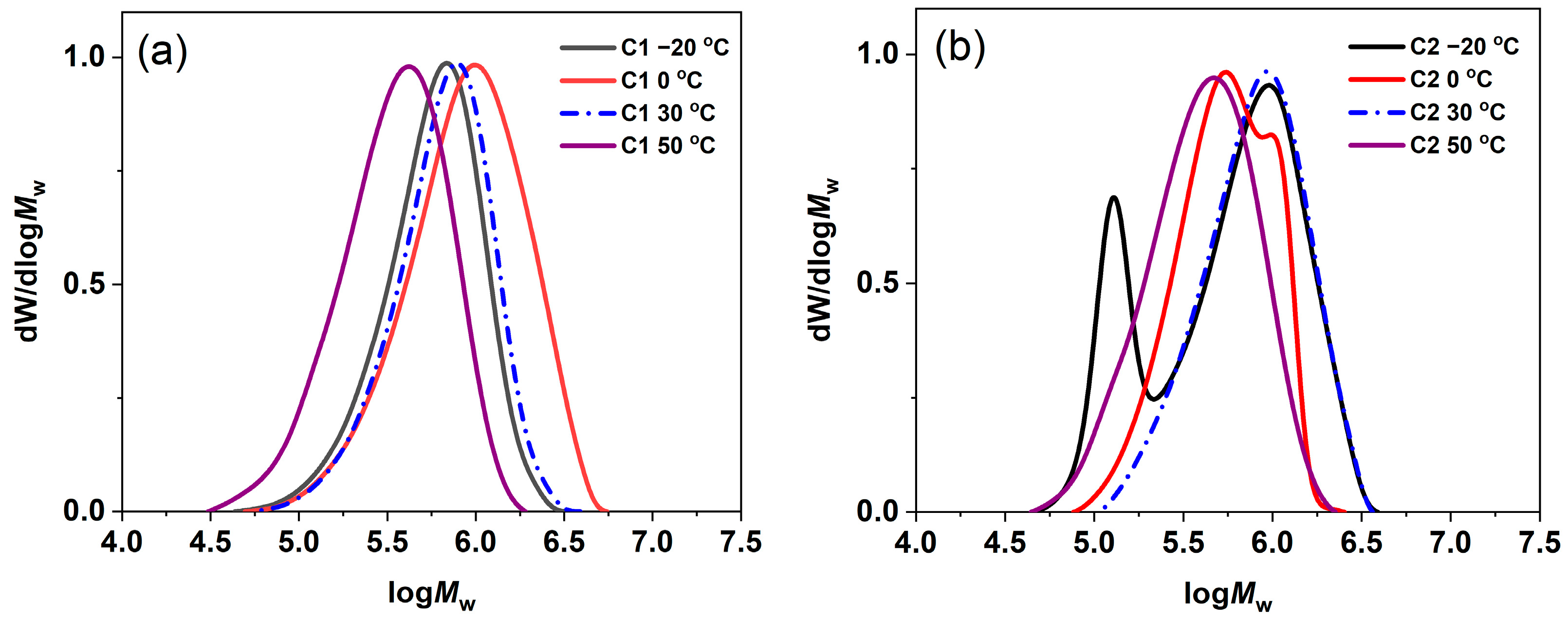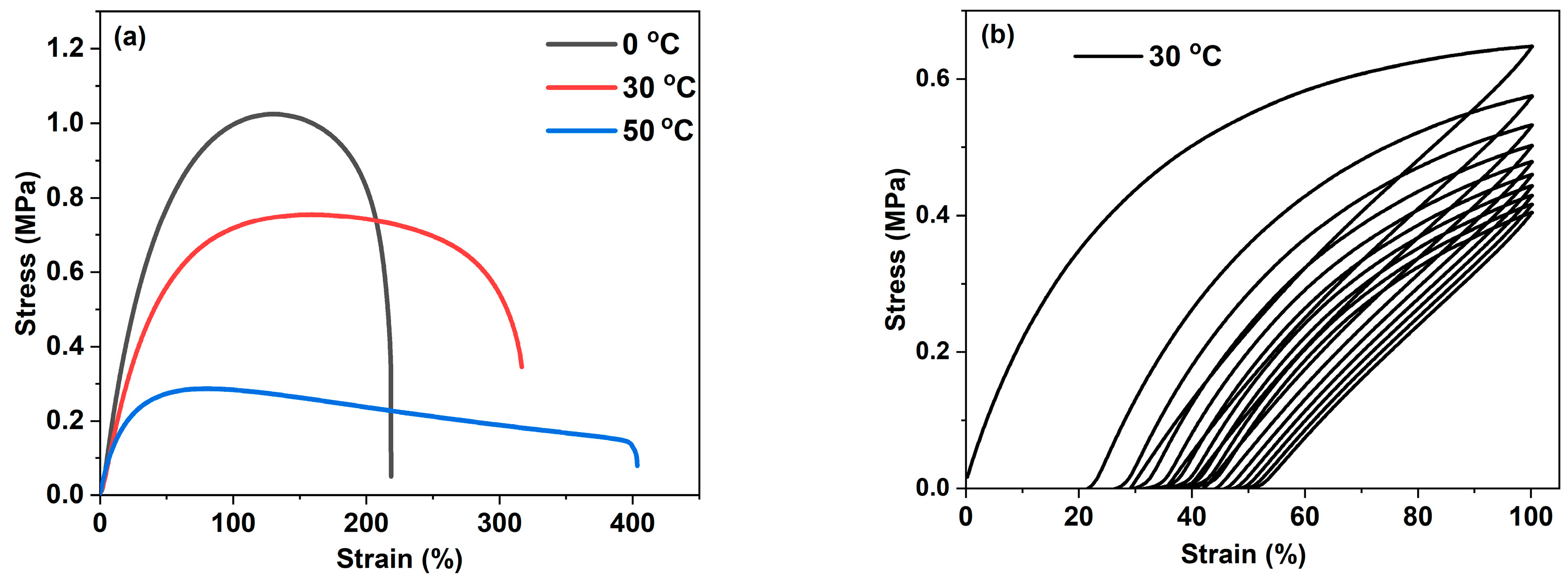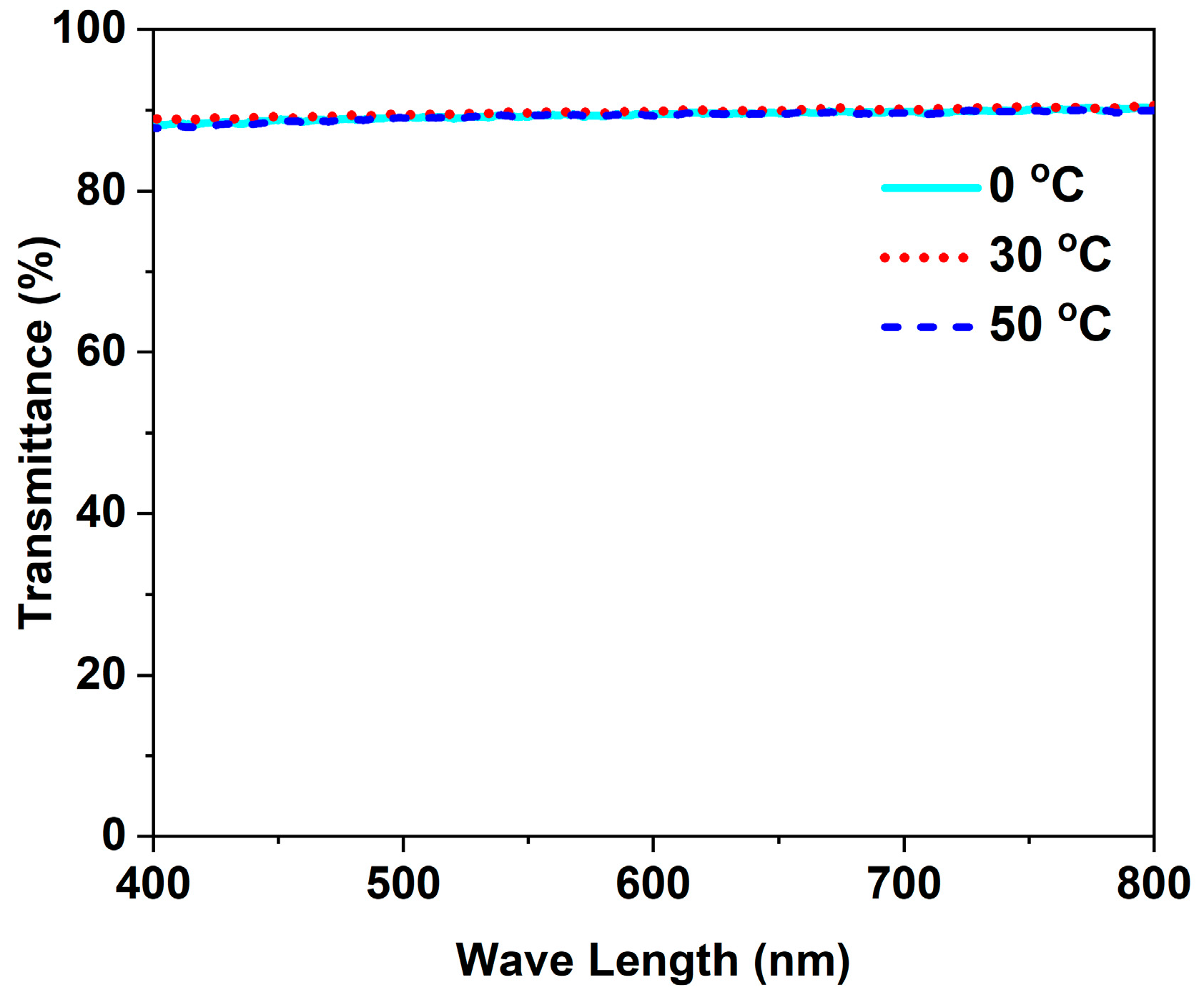Synthesis of High-Molecular-Weight Polypropylene Elastomer by Propylene Polymerization Using α-Diimine Nickel Catalysts
Abstract
:1. Introduction
2. Materials and Methods
2.1. General Methods and Materials
2.2. Characterizations
2.3. Preparation of α-Diimine Nickel(II) Complexes
2.4. Propylene Polymerization
3. Results and Discussion
3.1. Synthesis of α-Diimine Ligands and Complexes C1 and C2
3.2. Propylene Polymerization with α-Diimine Nickel (II) Complexes C1 and C2
3.3. Molecular Weight and Chain Structure of Polypropylene
3.4. Properties of Polypropylene
4. Conclusions
Supplementary Materials
Author Contributions
Funding
Institutional Review Board Statement
Data Availability Statement
Conflicts of Interest
References
- Kissin, Y.V.; Rishina, L.A.; Lalayan, S.S.; Krasheninnikov, V.G. A new route to atactic polypropylene: The second life of premetallocene homogeneous polymerization catalyst. J. Polym. Sci. Pol. Chem. 2015, 53, 2124–2131. [Google Scholar] [CrossRef]
- Schulze, U.; Sen, M.P.; Heinrich, G.; Stephan, M.; Gohs, U. Electron beam crosslinking of atactic poly(propylene): Development of a potential novel elastomer. Macromol. Mater. Eng. 2008, 293, 692–699. [Google Scholar] [CrossRef]
- Vaz, W.; Sheffield, J. Preliminary assessment of greenhouse gas emissions for atactic polypropylene (APP) modified asphalt membrane roofs. Build. Environ. 2014, 78, 95–102. [Google Scholar] [CrossRef]
- Debelova, N.N.; Suslyaev, V.I.; Gorlenko, N.P.; Zhuravlev, V.A.; Zav’yalova, E.N.; Dotsenko, O.A.; Zav’yalov, P.B.; Ul’yanova, O.A. Electrophysical properties of composites based on atactic polypropylene. Russ. Phys. J. 2014, 57, 306–311. [Google Scholar] [CrossRef]
- Rishina, L.A.; Kissin, Y.V.; Lalayan, S.S.; Krasheninnikov, V.G. Synthesis of atactic polypropylene: Ropylene polymerization reactions with TiCl4-Al(C2H5)2Cl/Mg(C4H9)2 catalyst. J. Appl. Polym. 2019, 136, 47692. [Google Scholar] [CrossRef]
- Saito, J.; Onda, M.; Matsui, S.; Mitani, M.; Furnyama, R.; Tanaka, H.; Fijita, T. Propylene polymerization with bis(phenoxy-imine) group-4 catalysts using iBu3Al/Ph3CB(C6F5)4 as a cocatalyst. Macromol. Rapid. Comm. 2002, 23, 1118–1123. [Google Scholar] [CrossRef]
- Lamberti, M.; Consolmagno, M.; Mazzeo, M.; Pellecchia, C. A binaphthyl-bridged salen zirconium catalyst affording atactic poly(propylene) and isotactic poly(α-olefins). Macromol. Rapid. Comm. 2010, 26, 1866–1871. [Google Scholar] [CrossRef]
- Coates, G.W.; Waymouth, R.M. Oscillating stereocontrol: A strategy for the synthesis of thermoplastic elastomeric polypropylene. Science 1995, 267, 217–219. [Google Scholar] [CrossRef]
- Dove, A.P.; Xie, X.J.; Waymouth, R.M. Cyclopentadienyl titanium hydroxylaminato complexes as highly active catalysts for the polymerization of propylene. Chem. Commun. 2005, 16, 2152–2154. [Google Scholar] [CrossRef]
- Wu, Q.L.; Su, Q.; Ye, L.; Li, G.H.; Mu, Y. Propylene polymerization to high molecular weight atactic polypropylene and copolymerization with 1-hexene using monocyclopentadienyl titanium catalysts. Dalton Trans. 2010, 39, 2525–2535. [Google Scholar] [CrossRef]
- Yang, M.; Hu, B.W.; Li, B.; Qu, J.Y.; Liu, B.Y.; Shen, X.L. Preparation of high molecular weight atactic polypropylene using ansa-metallocenes with doubly hetero-bridges. Acta Polym. Sin. 2016, 1, 25–30. [Google Scholar]
- Rice, C.G.C.; Buffet, J.-C.; Turner, Z.R.; O’Hare, D. Efficient synthesis of thermoplastic elastomeric amorphous ultra-high molecular weight atactic polypropylene (UHMWaPP). Polym. Chem. 2022, 13, 5597–5603. [Google Scholar] [CrossRef]
- Losio, S.; Bertini, F.; Vignali, A.; Fujioka, T.; Nomura, K.; Tritto, I. Amorphous elastomeric ultra-high molar mass polypropylene in high yield by half-titanocene catalysts. Polymers 2024, 16, 512. [Google Scholar] [CrossRef]
- Ittel, S.D.; Johnson, L.K.; Brookhart, M. Late-metal catalysts for ethylene homo- and copolymerization. Chem. Rev. 2000, 100, 1169–1203. [Google Scholar] [CrossRef]
- Johnson, L.K.; Killian, C.M.; Brookhart, M. New Pd(II)-and Ni(II)-based catalysts for polymerization of ethylene and α-olefins. J. Am. Chem. Soc. 1995, 117, 6414–6415. [Google Scholar] [CrossRef]
- AlObaidi, F.; Ye, Z.B.; Zhu, S.P. Ethylene polymerization with homogeneous nickel–diimine catalysts: Effects of catalyst structure and polymerization conditions on catalyst activity and polymer properties. Polymer 2004, 45, 6823–6829. [Google Scholar] [CrossRef]
- Rhinehart, J.L.; Brown, L.A.; Long, B.K. A robust Ni(II) α-diimine catalyst for high temperature ethylene polymerization. J. Am. Chem. Soc. 2013, 135, 16316–16319. [Google Scholar] [CrossRef] [PubMed]
- Mahmood, Q.; Zeng, Y.N.; Yue, E.L.; Solan, G.A.; Liang, T.L.; Sun, W.H. Ultra-high molecular weight elastomeric polyethylene using an electronically and sterically enhanced nickel catalyst. Polym. Chem. 2017, 8, 6416–6430. [Google Scholar] [CrossRef]
- Wang, Z.; Liu, Q.B.; Solan, G.A.; Sun, W.H. Recent advances in Ni-mediated ethylene chain growth: Nimine-donor ligand effects on catalytic activity, thermal stability and oligo-/polymer structure. Coord. Chem. Rev. 2017, 350, 68–83. [Google Scholar] [CrossRef]
- Pei, L.X.; Liu, F.S.; Liao, H.; Gao, J.; Zhong, L.; Gao, H.Y.; Wu, Q. Synthesis of polyethylenes with controlled branching with α-diimine nickel catalysts and revisiting formation of long-chain branching. ACS Catal. 2018, 8, 1104–1113. [Google Scholar] [CrossRef]
- Qin, L.D.; Wang, X.Y.; Mahmood, Q.; Yu, Z.X.; Wang, Y.Z.; Zou, S.; Liang, T.L.; Sun, W.H. High-performance α-diimine nickel complexes for facile access of PE elastomers with exceptional material properties. Chin. J. Polym. Sci. 2024, 42, 620–635. [Google Scholar] [CrossRef]
- Rose, J.M.; Cherian, A.E.; Lee, J.H.; Archer, L.A.; Coates, G.W.; Fetters, L.J. Rheological behavior of chain-straightened poly(α-olefin)s. Macromolecules 2007, 40, 6807–6813. [Google Scholar] [CrossRef]
- Leone, G.; Mauri, M.; Bertini, F.; Canetti, M.; Piovani, D.; Ricci, G. Ni(II) α-diimine-catalyzed α-olefins polymerization: Thermoplastic elastomers of block copolymers. Macromolecules 2015, 48, 1304–1312. [Google Scholar] [CrossRef]
- Leone, G.; Mauri, M.; Pierro, I.; Ricci, G.; Canetti, M.; Bertini, F. Polyolefin thermoplastic elastomers from 1-octene chain-walking polymerization. Polymer 2016, 100, 37–44. [Google Scholar] [CrossRef]
- Vaccarello, D.N.; O’Connor, K.S.; Iacono, P.; Rose, J.M.; Cherian, A.E.; Coates, G.W. Synthesis of semicrystalline polyolefin materials: Precision methyl branching via stereoretentive chain walking. J. Am. Chem. Soc. 2018, 140, 6208–6211. [Google Scholar] [CrossRef] [PubMed]
- Rose, J.M.; Cherian, A.E.; Coates, G.W. Living polymerization of α-olefins with an α-diimine Ni(II) catalyst: Formation of well-defined ethylene-propylene copolymers through controlled chain-walking. J. Am. Chem. Soc. 2006, 128, 4186–4187. [Google Scholar] [CrossRef] [PubMed]
- Mu, H.L.; Pan, L.; Song, D.P.; Li, Y.S. Neutral nickel catalysts for olefin homo- and copolymerization: Relationships between catalyst structures and catalytic properties. Chem. Rev. 2015, 115, 12091–12137. [Google Scholar] [CrossRef]
- Dai, S.Y.; Sui, X.L.; Chen, C.L. Highly robust palladium(II) α-diimine catalysts for slow-chain walking polymerization of ethylene and copolymerization with methyl acrylate. Angew. Chem. Int. Edit. 2015, 54, 9948–9953. [Google Scholar] [CrossRef] [PubMed]
- Mu, H.L.; Zhou, G.L.; Hu, X.Q.; Jian, Z.B. Recent advances in nickel mediated copolymerization of olefin with polar monomers. Coord. Chem. Rev. 2021, 435, 213802. [Google Scholar] [CrossRef]
- Zhang, Y.X.; Kang, X.H.; Jian, Z.B. Selective branch formation in ethylene polymerization to access precise ethylene-propylene copolymers. Nat. Commun. 2022, 13, 725. [Google Scholar] [CrossRef]
- Zheng, H.D.; Qiu, Z.L.; Li, D.H.; Pei, L.X.; Gao, H.Y. Advance on nickel- and palladium-catalyzed insertion copolymerization of ethylene and acrylate monomers. J. Polym. Sci. 2023, 61, 2987–3021. [Google Scholar] [CrossRef]
- Pellecchia, C.; Zambelli, A.; Oliva, L.; Pappalardo, D. Syndiotactic-specific polymerization of propene with nickel-based catalysts. 2. Regiochemistry and stereochemistry of the initiation steps. Macromolecules 1996, 29, 6990–6993. [Google Scholar] [CrossRef]
- Pellecchia, C.; Zambelli, A.; Mazzeo, M.; Pappalardo, D. Syndiotactic-specific polymerization of propene with Nickel-based catalysts. 3. Polymer end-groups and regiochemistry of propagation. J. Mol. Catal. 1998, 128, 229–237. [Google Scholar] [CrossRef]
- McCord, E.F.; McLain, S.J.; Nelson, L.T.J.; Arthur, S.D.; Coughlin, E.B.; Ittel, S.D.; Johnson, L.K.; Tempel, D.; Killian, C.M.; Brookhart, M. 13C and 2D NMR analysis of propylene polymers made with α-diimine late metal catalysts. Macromolecules 2001, 34, 362–371. [Google Scholar] [CrossRef]
- Cherian, A.E.; Rose, J.M.; Lobkovsky, E.B.; Coates, G.W. A C2-symmetric, living α-diimine Ni(II) catalyst: Regioblock copolymers from propylene. J. Am. Chem. Soc. 2005, 127, 13770–13771. [Google Scholar] [CrossRef]
- Rose, J.M.; Deplace, F.; Lynd, N.A.; Wang, Z.G.; Hotta, A.; Lobkovsky, E.B.; Kramer, E.J.; Coates, G.W. C2-symmetric Ni(II) α-diimines featuring cumyl-derived ligands: Synthesis of improved elastomeric regioblock polypropylenes. Macromolecules 2008, 41, 9548–9555. [Google Scholar] [CrossRef]
- Camacho, D.H.; Guan, Z.B. Living polymerization of α-olefins at elevated temperatures catalyzed by a highly active and robust cyclophane-based nickel catalyst. Macromolecules 2005, 38, 2544–2546. [Google Scholar] [CrossRef]
- Pourtaghi-Zahed, H.; Zohuri, G.H. Polymerization of propylene catalyzed by α-diimine nickel complexes/methylaluminoxane: Catalytic behavior and polymer properties. Polym. Bull. 2013, 70, 1769–1780. [Google Scholar] [CrossRef]
- Liu, J.; Chen, D.R.; Wu, H.; Xiao, Z.F.; Gao, H.Y.; Zhu, F.M.; Wu, Q. Polymerization of α-olefins using a camphyl α-diimine nickel catalyst at elevated temperature. Macromolecules 2014, 47, 3325–3331. [Google Scholar] [CrossRef]
- Guo, L.H.; Zou, C.; Dai, S.Y.; Chen, C.L. Direct synthesis of branched carboxylic acid functionalized poly(1-octene) by α-diimine palladium catalysts. Polymers 2017, 9, 122. [Google Scholar] [CrossRef]
- Fang, J.; Sun, X.L.; Li, Y.G.; Chen, C.L. Synthesis of polyolefin elastomers from unsymmetrical α-diimine nickel catalyzed olefin polymerization. Polym. Chem. 2018, 9, 4143–4149. [Google Scholar] [CrossRef]
- Wang, B.B.; Liu, H.; Zhang, C.Y.; Tang, T.; Zhang, X.Q. Propylene homopolymerization and copolymerization with ethylene by acenaphthene-based α-diimine nickel complexes to access EPR-like elastomers. Polym. Chem. 2021, 12, 6307–6318. [Google Scholar] [CrossRef]
- Fan, H.J.; Liao, Y.D.; Dai, S.Y. Propylene polymerization and copolymerization with polar monomers facilitated by flexible cycloalkyl substituents in α-diimine systems. Polymer 2022, 254, 125076. [Google Scholar] [CrossRef]
- Zhang, R.F.; Hou, Y.H.; Wei, X.L.; Zhao, D.D.; Cui, M.M.; Zhai, F.F.; Li, X.L.; Liu, B.Y.; Yang, M. Thermostable α-diimine nickel complexes with substituents on acenaphthequinone-backbone for ethylene polymerization. Chin. J. Polym. Sci. 2020, 38, 1214–1220. [Google Scholar] [CrossRef]
- Zhao, D.D.; Hou, Y.H.; Zong, K.N.; Cui, M.M.; Liu, B.Y.; Yang, M. Linear/branched block polyethylene produced by α-diimine nickel(II) catalyst and bis(phenoxy-imine) zirconium binary catalyst system in the presence of diethyl zinc. Chin. J. Polym. Sci. 2021, 39, 1581–1589. [Google Scholar] [CrossRef]
- Zhao, X.B.; Hou, Y.H.; Ye, L.L.; Zong, K.N.; An, Q.M.; Liu, B.Y.; Yang, M. Synthesis of α-diimine complex enabling rapidly covalent attachment to silica supports and application of homo-/heterogeneous catalysts in ethylene polymerization. Int. J. Mol. Sci. 2023, 24, 13645. [Google Scholar] [CrossRef]
- Maldanis, R.J.; Wood, J.S.; Chandrasekaran, W.A.; Rausch, M.D.; Chien, J.C.W. The formation and polymerization behavior of Ni(II) α-diimine complexes using various aluminum activators. J. Organomet. 2002, 645, 158–167. [Google Scholar] [CrossRef]
- Ma, X.; Zhang, Y.X.; Jian, Z.B. Tunable branching and living character in ethylene polymerization using “polyethylene glycol sandwich” α-diimine nickel catalysts. Polym. Chem. 2021, 12, 1236–1243. [Google Scholar] [CrossRef]
- Tempel, D.J.; Johnson, L.K.; Huff, R.L.; White, P.S.; Brookhart, M. Mechanistic studies of Pd(II)-α-diimine-catalyzed olefin polymerizations. J. Am. Chem. Soc. 2000, 122, 6686–6700. [Google Scholar] [CrossRef]
- Popeney, C.S.; Levins, C.M.; Guan, Z.B. Systematic investigation of ligand substitution effects in cyclophane-based nickel(II) and palladium(II) olefin polymerization catalysts. Organometallics 2011, 30, 2432–2452. [Google Scholar] [CrossRef]
- Mundil, R.; Sokolohorskyj, A.; Hošek, J.; Cvačka, J.; Císařová, I.; Kvíčala, J.; Merna, J. Nickel and palladium complexes with fluorinated alkyl substituted α-diimine ligands for living/controlled olefin polymerization. Polym. Chem. 2018, 9, 1234–1248. [Google Scholar] [CrossRef]
- Zhai, F.; Jordan, R.F. (α-Diimine)nickel complexes that contain menthyl substituents: Synthesis, conformational behavior, and olefin polymerization catalysis. Organometallics 2017, 36, 2784–2799. [Google Scholar] [CrossRef]
- Randall, J.C. A review of high resolution liquid 13carbon nuclear magnetic resonance characterizations of ethylene-based polymer. J. Macromol. Sci. Part C Polym. Rev. 1989, 29, 201–317. [Google Scholar] [CrossRef]
- Galland, G.B.; Da Sliva, L.P.; Dias, M.L.; Crossetti, G.L.; Ziglio, C.M.; Filgueiras, C.A.L. 13C NMR determination of the microstructure of polypropylene obtained with the DADNi(NCS)2/methylaluminoxane catalyst system. J. Polym. Sci. Pol. Chem. 2004, 42, 2171–2178. [Google Scholar] [CrossRef]
- Zanchin, G.; Leone, G. Polyolefin thermoplastic elastomers from polymerization catalysis: Advantages, pitfalls and future challenges. Prog. Polym. Sci. 2021, 113, 101342. [Google Scholar] [CrossRef]







| Entry | T °C | n(Al)/ n(Ni) | P MPa | Yield g | Act. b | Mnc kg/mol | Mwc kg/mol | PDI c | Tg °C |
|---|---|---|---|---|---|---|---|---|---|
| 1 | 30 | 900 | 0.5 | 0.97 | 3.23 | 397 | 654 | 1.6 | n.d. |
| 2 | 30 | 1200 | 0.5 | 1.10 | 3.67 | 373 | 736 | 1.9 | −33.2 |
| 3 | 30 | 1500 | 0.5 | 0.75 | 2.50 | 379 | 582 | 1.5 | n.d. |
| 4 | −20 | 1200 | 0.5 | 0.97 | 3.23 | 401 | 661 | 1.6 | −31.7 |
| 5 | 0 | 1200 | 0.5 | 1.62 | 5.40 | 548 | 1101 | 2.0 | −30.3 |
| 6 | 50 | 1200 | 0.5 | 0.58 | 1.93 | 215 | 407 | 1.9 | −35.8 |
| 7 | 60 | 1200 | 0.5 | 0.15 | 0.50 | n.d. | n.d. | n.d. | n.d. |
| 8 | 30 | 1200 | 0.7 | 0.86 | 2.87 | 425 | 808 | 1.9 | n.d. |
| 9 d | 30 | 1200 | 0.5 | 0.93 | 3.10 | 391 | 657 | 1.7 | n.d. |
| 10 d | 50 | 1200 | 0.5 | 0.48 | 1.60 | 131 | 250 | 1.9 | n.d. |
| Entry | T °C | n(Al)/ n(Ni) | P MPa | Yield g | Act. b | Mnc kg/mol | Mwc kg/mol | PDI c | Tg °C |
|---|---|---|---|---|---|---|---|---|---|
| 11 | 30 | 900 | 0.5 | 0.67 | 2.23 | 493 | 882 | 1.8 | n.d. |
| 12 | 30 | 1200 | 0.5 | 1.02 | 3.40 | 562 | 925 | 1.6 | −28.9 |
| 13 | 30 | 1500 | 0.5 | 0.70 | 2.33 | 483 | 798 | 1.7 | n.d. |
| 14 | −20 | 1200 | 0.5 | 0.53 | 1.77 | 116/667 | 127/978 | 2.6 | −30.0 |
| 15 | 0 | 1200 | 0.5 | 1.36 | 4.53 | 404 | 616 | 1.5 | −22.7 |
| 16 | 50 | 1200 | 0.5 | 0.50 | 1.67 | 268 | 480 | 1.8 | −32.3 |
| 17 | 60 | 1200 | 0.5 | 0.13 | 0.43 | n.d. | n.d. | n.d. | n.d. |
| Entry | Catalyst | T °C | P MPa | B a | [CH3]/[CH2] b | %1, 3 c |
|---|---|---|---|---|---|---|
| 5 | C1 | 0 | 0.5 | 257 | 0.86 | 5.15 |
| 2 | C1 | 30 | 0.5 | 249 | 0.73 | 10.98 |
| 6 | C1 | 50 | 0.5 | 234 | 0.62 | 16.96 |
| 8 | C1 | 30 | 0.7 | 242 | 0.68 | 13.56 |
| 15 | C2 | 0 | 0.5 | 280 | 0.90 | 3.57 |
| 12 | C2 | 30 | 0.5 | 254 | 0.74 | 10.48 |
| Sequences | Molar Content (%) | ||||
|---|---|---|---|---|---|
| C1/−20 °C | C1/0 °C | C1/30 °C | C1/50 °C | C2/30 °C | |
| [PPP] | 40.9 | 41.7 | 41.2 | 41.5 | 42.0 |
| [PPE+EPP] | 9.8 | 8.5 | 10.2 | 7.3 | 9.8 |
| [EPE] | 4.9 | 4.7 | 4.7 | 5.6 | 5.0 |
| [EEE] | 6.4 | 6.9 | 9.4 | 13.3 | 9.2 |
| [PEE+EEP] | 13.8 | 13.6 | 12.5 | 9.0 | 12.1 |
| [PEP] | 3.8 | 3.6 | 2.6 | 2.7 | 2.4 |
| [PP*P] | 1.9 | 2.2 | 0.8 | 0.0 | 1.2 |
| [PPP*] | 3.1 | 3.3 | 2.4 | 0.8 | 2.6 |
| [PP*PP] | 5.2 | 5.5 | 4.5 | 3.7 | 4.8 |
| [P*P*PP] | 3.0 | 3.2 | 3.4 | 4.4 | 3.3 |
| 1,4-B1betE | 2.6 | 2.1 | 1.8 | 1.9 | 1.7 |
| 1,6-β’B1 | 4.6 | 4.7 | 5.2 | 6.1 | 5.4 |
| [ELE] | 0.0 | 0.0 | 0.4 | 0.8 | 0.3 |
| [EiBuE] | 0.0 | 0.0 | 0.0 | 1.3 | 0.0 |
| [E2MHE] | 0.0 | 0.0 | 0.9 | 1.6 | 0.2 |
Disclaimer/Publisher’s Note: The statements, opinions and data contained in all publications are solely those of the individual author(s) and contributor(s) and not of MDPI and/or the editor(s). MDPI and/or the editor(s) disclaim responsibility for any injury to people or property resulting from any ideas, methods, instructions or products referred to in the content. |
© 2024 by the authors. Licensee MDPI, Basel, Switzerland. This article is an open access article distributed under the terms and conditions of the Creative Commons Attribution (CC BY) license (https://creativecommons.org/licenses/by/4.0/).
Share and Cite
Gao, L.; Ren, H.; Hou, Y.; Ye, L.; Meng, H.; Liu, B.; Yang, M. Synthesis of High-Molecular-Weight Polypropylene Elastomer by Propylene Polymerization Using α-Diimine Nickel Catalysts. Polymers 2024, 16, 2376. https://doi.org/10.3390/polym16162376
Gao L, Ren H, Hou Y, Ye L, Meng H, Liu B, Yang M. Synthesis of High-Molecular-Weight Polypropylene Elastomer by Propylene Polymerization Using α-Diimine Nickel Catalysts. Polymers. 2024; 16(16):2376. https://doi.org/10.3390/polym16162376
Chicago/Turabian StyleGao, Lujie, Hegang Ren, Yanhui Hou, Linlin Ye, Hao Meng, Binyuan Liu, and Min Yang. 2024. "Synthesis of High-Molecular-Weight Polypropylene Elastomer by Propylene Polymerization Using α-Diimine Nickel Catalysts" Polymers 16, no. 16: 2376. https://doi.org/10.3390/polym16162376
APA StyleGao, L., Ren, H., Hou, Y., Ye, L., Meng, H., Liu, B., & Yang, M. (2024). Synthesis of High-Molecular-Weight Polypropylene Elastomer by Propylene Polymerization Using α-Diimine Nickel Catalysts. Polymers, 16(16), 2376. https://doi.org/10.3390/polym16162376






